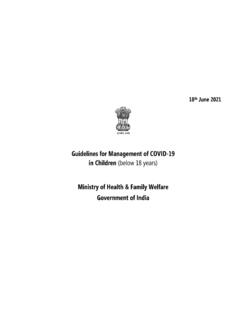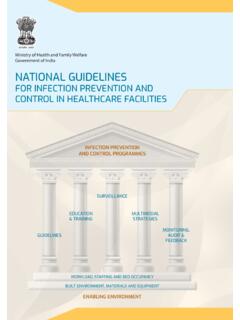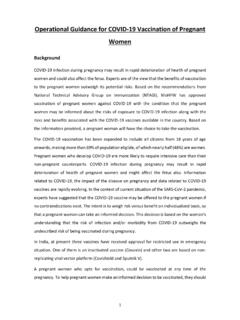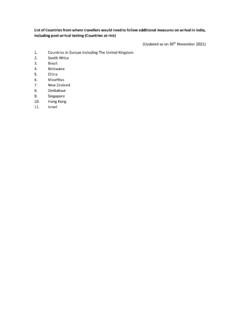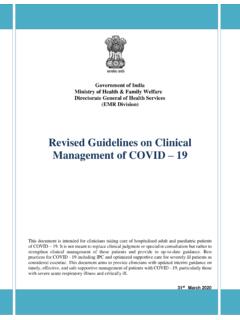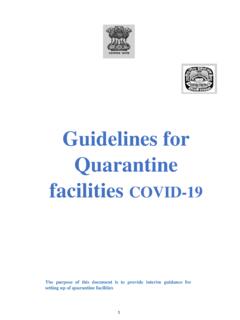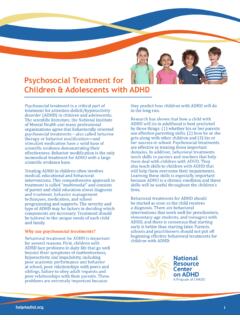Transcription of Guidelines on Operationalization of COVID Care Services ...
1 1 | P a g e Guidelines on Operationalization of COVID Care Services for children & Adolescents Government of India Ministry of Health and Family Welfare June, 2021 2 | P a g e Guidelines on Operationalization of COVID Care Services for children & Adolescents Table of contents Topic Page 1. Executive Summary 4 2. Introduction 6 3. Estimated burden of COVID -19 in children 7 4. Development of Guidance to Prepare for Managing an increased number of children and Adolescents with COVID -19 8 5. Proposed Operationalization 8 6. Requirements for Pediatric COVID Care 9 7. Suspecting COVID -19 and testing in children 10 8. Management of COVID -19 cases at community level 11 9. Community level preparations 11 10. Categorization of COVID Health Facilities 12 11.
2 Triaging/ deciding the level of care of children with COVID -19 14 12. Types of health facilities presently functional for care of patients with active COVID -19 14 13. Augmentation of the above facilities for pediatric care 15 14. Provisions to allow parent/ family member to stay with the child 17 15. Augmentation of existing pediatric care facilities to provide care to children with MIS-C 17 16. Augmenting bed capacity for pediatric care in urban, peri urban and rural area 18 17. Admission criteria in different types of health facilities 19 18. Initial Screening and Triage 1 at the health facility 19 19. Hospital Infrastructure (DCHC/DCH) 21 20. Training 24 21. Equipment 24 22. Infection Prevention and control 24 23. Disposal of the deceased 25 24.
3 Discharge criteria 25 25. Post COVID care 25 26. Care of neonates born to COVID -19 positive mothers and newborn developing infections 26 27. Registry 28 28. Appendix 1: Checklists for surveillance and monitoring by ANM/ASHA 30 Appendix 2: Specific requirements for Inter- Facility transport transfer to a higher facility 35 Appendix 3: Common Services for all type of health facilities 38 Appendix 4: Human Resource 40 Appendix 5: Equipment/ Medications required at various levels of health care 41 Appendix 6: Governance 44 Appendix 7: Equity and Dignity of Care 46 29. Team members 48 3 | P a g e List of Abbreviations: AED : Automated External Defibrillator AGP : Aerosol Generating Procedure ALS : Advanced Life Support ANM : Auxiliary nurse midwife ASHA : Accredited Social Health Activist AYUSH : Ayurveda, Yoga and Naturopathy, Unani, Siddha and Homeopathy BiPAP : Bilevel Positive Airway Pressure BLS : Basic Life Support BP : Blood Pressure BVM : Bag Valve Mask CBNAAT : Cartridge based Nucleic Acid Amplification Test CBWTF : Common Biomedical Waste Treatment and Disposal Facility CCC : COVID -19 Care Centre CCTV : Close Circuit Television CHC : Community Health Centre CHO : Community Health Officer CMHO : Chief Medical Health Officer COVID -19: Coronavirus disease 2019 CPAP.
4 Continuous Positive Airway Pressure CPCB : Central Pollution Control Board CPR : Cardiopulmonary Resuscitation CRP : C-reactive protein CRRT : Continuous Renal Replacement Therapy CSSD : Central Sterile Services Department CT : Computed Tomography DCH : Dedicated COVID -19 Hospital DCHC : Dedicated COVID -19 Health Centre DH : District Hospital DNS : Deputy Nursing Superintendent ECG : Electrocardiogram ER : Emergency Room ETCO2 : End-tidal Carbon Dioxide ETT : Endotracheal Tube FRU : First Referral Unit GDMO : General Duty Medical Office HCW : Health Care Worker HD : Hemodialysis HDU : High Dependency Unit HFNC : High Flow Nasal Cannula HR : Human Resources HWC : Health and Wellness Center ICMR : Indian Council of Medical Research ICU : Intensive Care Unit IEC : Information Education and Communication iGOT : Integrated Government Online Training IMA : Indian Medical Association IMNCI : Integrated Management of Neonatal and Childhood Illness IPC : Infection Prevention and Control IPHS : Indian Public Health Standards IV : Intravenous LMA : Laryngeal Mask Airway LMO : Liquid Medical Oxygen LMWH : Low Molecular Weight Heparin MDI : Multi-dose inhaler MIS-C : Multisystem Inflammatory Syndrome in children MO : Medical Officer MoHFW : Ministry of Health and Family Welfare MPW : Multi-purpose Worker MS : Medical Superintendent NCDC : National Centre for disease Control NGO : Non-governmental organization NIBP.
5 Non-invasive blood pressure NICU : Neonatal intensive care Unit OPD : Out Patient Department PCR : Polymerase Chain Reaction PD : Peritoneal Dialysis PHC : Primary Health Centre PPE : Personal Protective Equipment PSA : Pressure Swing Adsorption QoC : Quality of Care RKS : Rogi Kalyan Samiti RT PCR : Reverse Transcriptase Polymerase Chain Reaction SARS-CoV-2: Severe Acute Respiratory Syndrome Coronavirus 2 SNCU : Special Newborn Care Unit SOP : Standard Operating Procedure UHF : Unfractionated Heparin USG : Ultrasonography UT : Union Territory 4 | P a g e Guidelines on Operationalization of COVID Care Services for children & Adolescents Executive Summary 1. Based on sero-surveillence reports, COVID 19 infection in children above 10 years of age occurs in similar frequency to that of adults, even though, among the confirmed cases <12% are individuals < 20 yr age.
6 2. children have less severe disease than adults. In the majority, infection is asymptomatic or mildly symptomatic. It is uncommon to have moderate to severe COVID in healthy children . children with co-morbid conditions have more severe manifestations and poorer outcomes; they should be a priority group for vaccination, once vaccines are approved for children . 3. It is anticipated that there may be intermittent surges in the number of cases. A combined effort from private & public sector is needed to handle any surge in future after the withdrawal of the lockdown, school re-opening or as third wave over next 3-4 months. 4. The basic principles of equity and dignity of care should be followed. 5. The estimates for additional bed capacity for pediatric care may be calculated based on the peak daily cases in different districts during the second wave.
7 From this number, projections for pediatric cases and number of admissions required can be derived. 6. It is desirable to augment the existing COVID care facilities to provide care to children with acute COVID . This will need additional pediatric specific equipment, infrastructure, and pediatric formulations. Also, adequate number of trained manpower- both doctors and nurses should be provided. The health authorities should initiate capacity building programs for appropriate pediatric care. In standalone paediatric hospitals, separate arrangements for example - separate bed for paediatric COVID care need to be established. 7. It is desirable to designate specific areas in the COVID facilities for pediatric care.
8 These facilities should allow parents to accompany the child. 8. For children with MIS-C, who test negative for acute COVID , care has to be provided by the existing pediatric facilities. These facilities also need augmentation esp. HDU and ICU Services . 9. The document provides guidance about additional requirements for infrastructure, equipment and manpower. 10. The management protocols for children with acute COVID and MIS-C have been developed by the MoHFW*. Most drugs used in adults such as Ivermectin/ HCQ/ Favipiravir/ Antibiotics such as Doxycycline or Azithromycin have not been tested in 5 | P a g e children for prevention or treatment of COVID infection in children . Therefore, these are not recommended in children .
9 11. Majority of children have asymptomatic or mild illness and can be managed at home by parents. Treatment is symptomatic including paracetamol for fever, good monitoring for worsening by measuring respiratory rates, difficulty in respiration, oral intake and oxygen saturation. In a community setting, ASHA / MPW should be involved for management of children at home and also monitor to assess the need for referral/ admission. 12. National programs like IMNCI are in place in the country; COVID care should be embraced in the same with follow up for children . At the community level, it is important to train community health workers to pick red flag signs. Additionally, all stake holders including the community should be educated by IEC.
10 13. Medical officers should provide leadership to ensure service delivery locally by involvement of community health workers. 14. For improving the quality of care and for capacity building, hand-holding of district hospitals and other facilities should be taken up by the medical colleges. Few centers may be designated as the Regional Centres of Excellence for COVID care as well as research. These centers can provide leadership in clinical management and training. Telemedicine could be harnessed for reaching out to large number of facilities. 15. Data drives science, the importance cannot be over emphasised. Therefore, it is important to ensure data collection at all levels and transmission from community to higher centers.
